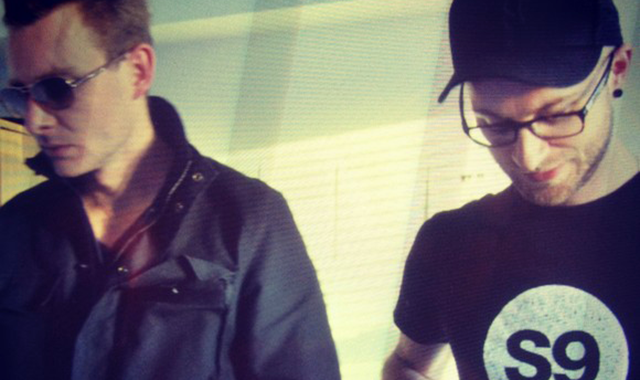
We yearn to understand the motives of criminals. It's natural. So when a museumgoer by the name of Vladimir Umanets brashly tagged of one of Mark Rothko's Seagram murals at the Tate Modern on Sunday with the words "A potential piece of yellowism," observers seized on the term as a key to understanding his brutal action (he has since been arrested). What does "yellowism" mean? Why did Umanets commit a senseless act of destruction in its name?

Marcin Łodyga and Vladimir Umanets / Courtesy ThisIsYellowism
Not long after the crime hit newswires, intrepid reporters tracked down a website for the movement. There's also a YouTube channel. And a Facebook page. (And now a few attempts to explain it.) After an hour spent watching dull videos and reading manifestos, here is what we can tell you: Yellowism appears to be a novel -- if violent, misguided, and, to many, abhorrent -- update to Situationism and appropriation art. Bear with us while we explain.
"Yellowism is not art, and Yellowism isn't anti-art," Umanets told the Telegraph on Monday. "It's an element of contemporary visual culture. It's not an artistic movement. It's not art, it's not reality, it's just Yellowism. The main difference between Yellowism and art is that in art you have got freedom of interpretation, in Yellowism you don't have freedom of interpretation, everything is about Yellowism, that's it."
If the founders of Yellowism -- Russian-born Umanets and his partner Marcin Łodyga -- display an object or work of art in a "yellowism" exhibition or tag it with the movement's name, they believe it becomes part of the movement. No matter what. Its significance as anything beyond a work of "yellowism" is summarily erased.
While Duchamp appropriated a urinal and, with his signature, created a work of art, Umanets believes any existing work of art can be transformed into a work of Yellowism by adding his own signature. "I am not a vandal," he told the Telegraph. "In Yellowism, all the possible interpretations are reduced to one -- are equalized, flattened to yellow."
The movement supposedly began on November 15, 2010 in Giza, Egypt, where the duo unveiled their first exhibition, "Flattened to Yellow." Little is known about the venue except its address: 15 Damascus Street. Photos of the exhibition show a yellow room with the words "Jamon Jamon" painted on one wall (the name of a sexy early Penelope Cruz movie) and a large wooden panel painted yellow and red, identified as "First Yellowistic Form (North Africa Version)."
In May of last year, they organized their third exhibition, "No One Lives Forever," at a former brewery in London. The show advertised work by YBA Damien Hirst, Polish artist Mirosław Bałka, and designer Neville Brody, according to its website. A YouTube video associated with the exhibition shows Umanets and Lodyga signing their names on a projector screen, which would later present Balka's film "B" -- presumably claiming the work for Yellowism. According to the text accompanying the video, "Bałka's film 'B' in this particular case for the first time was considered as a pure expression of a yellow colour only."
Catastrophic Rothko defacement notwithstanding, the reality of Yellowism seems a bit more mundane than its heavy-handed rhetoric would suggest. One YouTube video on the group's channel captures Umanets and his partner installing a run-of-the-mill art exhibition in a yellow room. (In order to be subsumed into Yellowism, artworks must either be displayed in a yellowistic chamber -- a non-traditional gallery space painted yellow -- or signed by a Yellowist.) Another video, titled "Hungry yellowists," features the two men eating at McDonald's.
In general, their movement shows an adolescent obsession with vandalism and attractive women -- at least one of their videos is simply an appropriated slow-mo clip of Russian swimsuit models. (The first Yellowist exhibition in Giza was subtitled "Natalia Vodianova Yellowistic Chamber," referring to a famous Russian beauty; "No One Lives Forever" was subtitled "Carmen Kass Yellowistic Chamber," referring to an Estonian model.)
Yellowism's Facebook page provides little additional insight, though it does boast dozens of comments scolding the founders for their crime. (Sample post: "Congratulations. the next time i go to a gallery and have to view artwork through plexiglass from 10 yards or have a security guard breathing down my neck destroying any intimacy with a piece i'll thank you.")
To be sure, there is nothing in Yellowism that redeems the destruction of an iconic painting. Within the realm of art, vandalism is the ultimate transgression, and vandals are regarded with a combination of fascination and disgust. Umanets's act is particularly shocking because viewing Rothko's artwork is, for many, a spiritual experience. In Houston, the Rothko Chapel is a sanctuary for people who believe in the power of God -- or simply the power of Rothko. Even Umanets understood Rothko's mythic power: He told the U.K. Times he elected to tag the Rothko over paintings by Pollock and Picasso because it expressed his emotions so well.
If Umanets's vandalism was a horrid experiment to gauge the power of a home-grown artistic movement, maybe he's learned something here. Some works of art are simply too weighty to yield to Yellowism.
-Julia Halperin, BLOUIN ARTINFO
More of Today's News from BLOUIN ARTINFO:
Like what you see? Sign up for BLOUIN ARTINFO's daily newsletter to get the latest on the market, emerging artists, auctions, galleries, museums, and more.